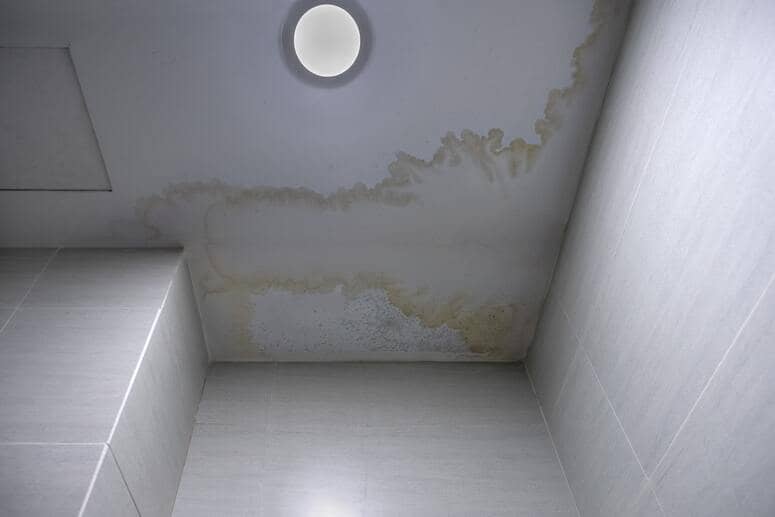Ceiling leak detection
Ceiling leaks can be more than a nuisance. They can also cause serious harm to your property. The right plan of action depends on the source of the leak. If you’re unsure, it’s best to call in a professional to help you mitigate and repair any water damage.
You’ve got a ceiling leak, and you need to find it. You start looking at the ceiling and see water stains and pools of water on the top side of your ceiling. But where is that water coming from?

To detect a ceiling leak, you need to know what kind of ceiling it is.
Now that you know what to look for, here are some tips on how to detect a leak in your ceiling and how to fix it:
- Identify the type of ceiling you have.
- Check for moisture stains around light fixtures and electrical outlets. These could indicate a leaky pipe or fixture above.
- Listen for dripping water; this will help you identify where the leak is coming from—usually an attic or basement ceiling rather than a wall or floor.
Finding out what kind of ceiling you have will help identify different places to look for the source of a roof leak. Here are some common types of ceilings and how to find leaks associated with each one:
False ceiling
False ceilings are an essential element of any ceiling. They can be used to make a room look more prominent, and they also have the added benefit of hiding ducts, pipes and wires. However, leaks do happen in false ceilings; this is why it’s essential to know how to detect and repair them.
Here’s what you need to know:
- A leaky pipe or vent can damage your flooring, furniture and walls. And if it’s a central air conditioning system leak, it may be difficult for you to pinpoint where exactly the problem lies because the condensation from your AC unit’s refrigerant lines can build up on top of the entire ceiling when there are no other leaks present—creating an illusion that there isn’t anything wrong with your home’s HVAC system at all! The best way around this dilemma? Start by checking these familiar places:
- Ceiling lights
- Light fixtures
- Air registers/vents
Call now for a free estimate!
Plasterboard
Plasterboard is a building material that’s used for walls and ceilings. It’s a type of wallboard, which means it has a smooth surface and can be painted, but it also provides some fire resistance. Plasterboard is made from gypsum plaster, which dries to form a tough exterior that’s resistant to both moisture and mould.
Since plasterboard is an inert material made with gypsum, it’s not uncommon for cracks or holes to form on the surface over time as the product ages. These cracks are sometimes repaired with spackling compound or other fillers before painting can happen—the last thing you want during your renovation project is a leaky ceiling!
Drywall
Drywall is plasterboard made of gypsum plaster and glue. It’s called “drywall” because the water-based adhesive dries, hardening the bond between sheets of drywall. Drywall is an excellent insulator and a good choice for exterior walls, but it should not be used as interior wall insulation because it can be damaged by water (like in your bathroom).
The downside to drywall is that it costs more than plasterboard (which also needs insulation), especially if you have old homes with brick or concrete walls.
Rafter/slab ceiling
If you think your ceiling is a rafter/slab ceiling, the best thing to do is call in a professional. But if you don’t want to pay for that kind of service and are willing to take on the task yourself, here are some helpful tips:
- Check for ceiling leaks at the top of your walls. If you see moisture stains or discolouration above them, there may be water damage.
- Look for wet spots on the floor below windows and doors. If any exist, they could indicate where water is coming through from above and causing problems in lower portions of your home as well as up high where it starts leaking into ceilings themselves (and then dripping down onto floors).
Wooden batten ceiling
They are usually used in rooms with high ceilings, as they provide an easy way to fill the space and create a more natural look.
Wooden batten ceilings are usually made of oak or pine, but any wood can be used as long as it is smooth and finished.
Call now for a free estimate!
Gypsum plasterboard or drywall
To detect a leak in gypsum plasterboard or drywall ceiling, you can:
- Use a leak detector. These look similar to smoke detectors and emit an alarm when they detect moisture.
- Use a moisture meter. Moisture meters measure the amount of water vapour in the air, which indicates that there’s either high humidity or condensation occurring on your ceiling (which means that it has been wet for some time).
- Use thermal imaging cameras if you have access to one—they’ll show heat signatures from leaks as well as cool spots where excess heat is escaping from your house through gaps around windows or doors etc., which could be signs of drafts caused by holes in insulation but also could mean that there may be hidden cracks forming on walls/ceilings because of uneven temperature differences between inside and outside air temperatures over time!
Brick slab or concrete slab ceiling
If you have a concrete slab ceiling, it will be your responsibility to prepare the area for inspection by removing any obstructions that might interfere with the inspection process. If you have a brick or stone tile ceiling, then your contractor will have to remove these materials before he can inspect your insulation and air conditioning ducts. Once this is done, he can proceed to check these areas for signs of leaks and moisture damage.
Ceiling leaks can come from many sources, one of which is a leaking roof.
Leaks in your ceiling can come from many sources, one of which is a leaking roof. Roof leaks are common and can be caused by many things, including wear and tear, age, weather conditions and more. If you have noticed water stains on the ceiling of your home or if the room has developed an unpleasant smell, then it may be time to call in a professional for help with finding the source of the problem.
Water in the house can also damage walls, furniture and carpets creating ceiling leaks.
Water in the house can also damage walls, furniture and carpets. A leaky roof or pipes can cause water damage that can cause mould and mildew to grow. Mould is a fungus that grows on organic materials like wood, paper and fabric. It affects the air quality of your home and causes health problems for people who are allergic or sensitive to it. Mildew is an algae-like substance that grows in damp areas such as showers or basements. It damages furniture if left untreated for long periods of time because it eats away at fabrics such as leathers, suede and upholstery over time.
Water leaks cost thousands of dollars each year due to carpet cleaning/replacement costs which may not cover replacement costs if needed!
Call now for a free estimate!
But beyond just the damage, water leaks are bad for your health.
But beyond just the damage, water leaks are bad for your health. They can cause mould to grow and spread within your home, which can lead to respiratory issues like asthma and skin problems. Some moulds are toxic, so it’s crucial that you ensure you’re not breathing them in every day. This is especially important if you or anyone else living in your home has a weakened immune system or allergies!
Other causes of water damage include burst pipes and damaged guttering.
There are a number of other causes of water damage, including burst pipes and damaged gutters. If you have a leaking roof, then this can cause severe problems for your home and its contents.
Any area where there is moisture on the ceiling or walls should be treated as a potential source of water damage and assessed by an expert professional immediately.
But if you have tried to fix a ceiling leak yourself and can’t find the cause, it’s time to call in a professional.
If you have tried to fix a ceiling leak yourself and can’t find the cause, it’s time to call in a professional. A leak can be very frustrating for homeowners, but if you have tried your best to find the source of the leak yourself and still cannot locate it, it may be time for us to help.
The professionals at our company use state-of-the-art technology that allows them to pinpoint where water is entering your home or business before repairing it. We are able to make proper repairs quickly so that no more damage occurs from prolonged exposure to mould or mildew.
We also have a 24-hour emergency service line, so if you notice any signs of leaking around midnight or during business hours on Sundays when most stores are closed for maintenance purposes (which can often lead people to think that their problem has gone away), don’t hesitate! Call us right away; we’ll take care of whatever needs fixing immediately.
A specialist will be able to find the source of the leak using state-of-the-art technology before repairing it.
When you come in contact with a ceiling leak, it’s essential to find the source of the leak as quickly as possible. The specialist will be able to locate and repair the source of the problem using state-of-the-art technology before it becomes a significant issue that requires additional repairs.
Call now for a free estimate!
If you want to get rid of ceiling leaks, call out a qualified water leak detection expert.
If you want to get rid of a leak in the ceiling, call out a qualified water leak detection expert. Water leak detection can be tricky—a lot of people think they can do it themselves but don’t realize that there are special tools and techniques involved. Even if you’ve had experience with other types of home repairs, this is not something to attempt on your own. A professional will be able to find the source of your ceiling leak quickly and accurately, which will save you time and money down the road. If you have an emergency situation like a burst pipe or sewer backup, it’s essential that you act quickly so that as minor damage as possible is done to your home or business property.
Conclusion
It can be hard to know what to do when you have a leak in your ceiling. The good news is that with these tips, you should be able to figure out what type of ceiling you have and, therefore, how best to repair it. You might even save yourself some time and money by not having to call in a professional before starting work yourself! Do remember, though, that if there’s an issue with your roof or other building components, then these tips won’t necessarily apply, so make sure you check them first (and get them fixed).
We hope that this article has been helpful and that you have gained a greater understanding of the causes of water leaks in your ceiling, as well as some tips on how to fix them. Water leaks can be dangerous and destructive, so it’s essential to get them repaired before they cause any severe damage. If you want more information about leak detection services or want someone to take action immediately on your behalf, then contact us today for advice.











